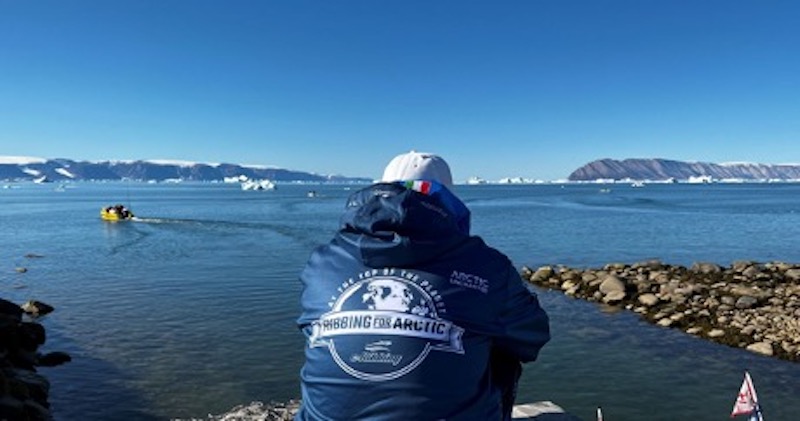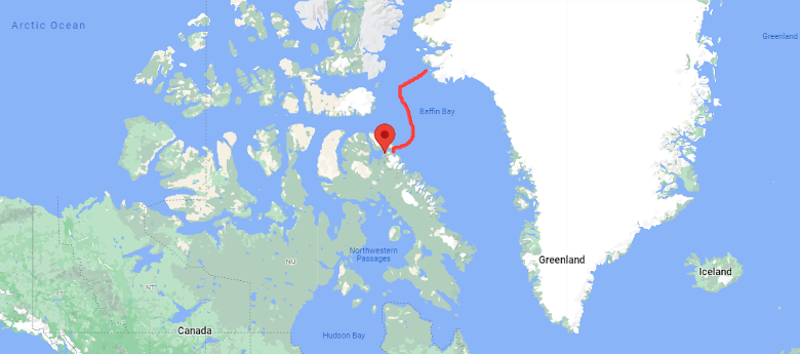Arctic by RIB - Episode 14 Isolated in Qaanaaq

We now had some experience in navigating in serious ice conditions, and a better idea of what to expect to the west. We had dealt with ice conditions which were between 40 to 60 percent coverage of the sea surface.
In addition we had repeatedly navigated in very dense fog, 0 degrees air temperature and bitter cold, elements that constitute the highest degree of difficulty for every boat and crew. The only thing that really scared us was that none of us knew what we would meet next.
DAY 35th – Saturday, August 6
The day greeted us with clear air, bright sun and a temperature of 12°C, which felt like 30 degrees to us. We decided to tour the neighboring glaciers, taking advantage of the rare sunny day. We cleaned the boat and in a short time we were in the midst of the most impressive glaciers in the area.

We moved slowly through fields of scattered ice that filled the sea in all directions around the glaciers. Cris stood on the bow and, with the long carbon pole we had made for this purpose, cleared the way for us by pushing the blocks of ice out of our way.
We were trying to get as close to the glacier as we could so that we could immediately admire the sight. It took us more than an hour to get there but it was worth the effort. The glacier was several hundred meters long and over 30 meters (98’) high.

Of course, we were standing off the glacier at a safe distance with the bow facing the open sea, because we knew very well that if suddenly a large iceberg broke off and collapsed into the sea, a small but dangerous tsunami would be created. The locals made us aware that this can be very risky for boats that get too close.
There is no warning for this, other than a loud noise that sounds like an explosion just a few fractions of a second before the iceberg collapses.

While keeping an eye on the edge of the glacier, we also listened carefully—but the only sound was massive silence—no wind noise, no gulls, just a great, calm silence.

Although it was late noon, we spread the small trays on the aft sundeck and scooped out small breads and honey. It was a magical scene for an extended lunch before we reluctantly headed back to the harbor.
DAY 36th – Sunday, August 7
That morning we took out our maps, opened the computer and studied the forecasts for the next few days. Grise Fjord continued to look ice-locked while nor'easters were forecasted to rage for days to come.
It was beginning to seem that we had no chance of approaching the Northwest Passage.
We didn't leave the hotel that day. We were trying to find some solution but it was impossible. Approaching the shores of Canada now seemed like a midsummer night's dream.
Perhaps the End of the Mission—Or Could There Still be Hope?
We now began to accept the crushing realization that this might be the end of the mission. All our efforts, all the hard days and weeks at sea, all the expense and struggle would not be rewarded with the success we had hoped for.
It looked like we had to figure out how to get back to Upernavik without going further in our quest.

After midnight we all went to bed, but my eyes wouldn't close. Although I was incredibly disappointed, I also felt a certain peace because the tension of navigating more unknown waters ahead was gone.
We still had to find our way back, however, and that would not necessarily prove easy.
DAY 37th/38th – Monday/Tuesday August 8-9
Those days of waiting at Qaanaaq for a break in the weather and ice conditions dragged on. We continued to parse the forecasts, but there seemed no ray of hope.

Most of the Northwest Passage still seemed ice-locked and the winds for the next week were strong so it was not worth the risk to even go to Pond Inlet where there was a good chance of being stranded by fast moving ice.

Meanwhile the large icebergs and glaciers continued to feed the local icefields, giving us a preview of what we could expect at sea.
In the morning, the bay was empty of small pieces of ice, but by afternoon it would be full of chunks of all shapes and sizes, potential trouble for our lower units and our hull.
On Tuesday morning we went to the gas station to refuel the boat. We filled the 600-liter (162 gal.) flexible tank and carried it twice with the help of a local who told us he was one of the oldest Eskimos in the area.

At noon he invited us to his home and told us stories from the past, about the ways they hunted and the harsh conditions of survival before global warming affected their way of life.
In the evening we returned to our apartment and sat around the table. We had to make a decision as in a few hours it would be "dawn" on Wednesday and we would be untying the bow lines.
Although none of us wanted to, putting safety first, we unanimously agreed to end the mission and return to Upernavik and then Nuuk.
But things have a strange way of turning around—as you’ll see in the next installment.
The adventure continues, with more unexpected twists—read Episode 15 in in BoatTEST’s next “On the Water” newsletter.